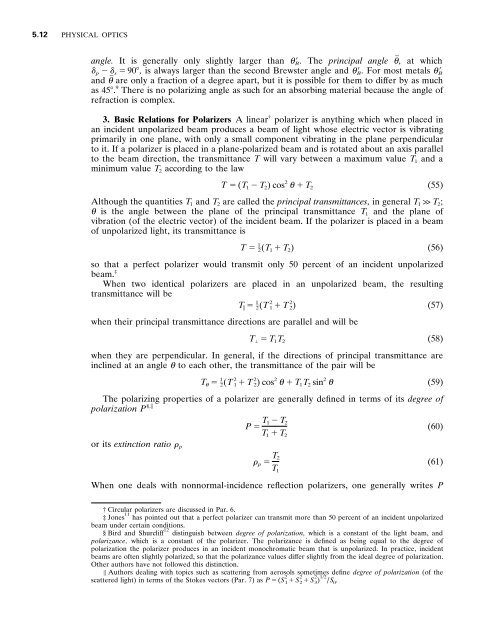Chapter 5 . Polarization
Chapter 5 . Polarization
Chapter 5 . Polarization
Create successful ePaper yourself
Turn your PDF publications into a flip-book with our unique Google optimized e-Paper software.
5 .12 PHYSICAL OPTICS<br />
angle . It is generally only slightly larger than θ B . The principal angle θ , at which<br />
p s 90 , is always larger than the second Brewster angle and θ B . For most metals θ B<br />
and θ are only a fraction of a degree apart , but it is possible for them to dif fer by as much<br />
as 45 . 9 There is no polarizing angle as such for an absorbing material because the angle of<br />
refraction is complex .<br />
3 . Basic Relations for Polarizers A linear † polarizer is anything which when placed in<br />
an incident unpolarized beam produces a beam of light whose electric vector is vibrating<br />
primarily in one plane , with only a small component vibrating in the plane perpendicular<br />
to it . If a polarizer is placed in a plane-polarized beam and is rotated about an axis parallel<br />
to the beam direction , the transmittance T will vary between a maximum value T 1 and a<br />
minimum value T 2 according to the law<br />
T ( T 1 T 2 ) cos 2 θ T 2 (55)<br />
Although the quantities T 1 and T 2 are called the principal transmittances , in general T 1 apple T 2 ;<br />
θ is the angle between the plane of the principal transmittance T 1 and the plane of<br />
vibration (of the electric vector) of the incident beam . If the polarizer is placed in a beam<br />
of unpolarized light , its transmittance is<br />
T 1 – 2 ( T 1 T 2 ) (56)<br />
so that a perfect polarizer would transmit only 50 percent of an incident unpolarized<br />
beam . ‡<br />
When two identical polarizers are placed in an unpolarized beam , the resulting<br />
transmittance will be<br />
T 1 – 2 ( T 2 1 T 2 2 ) (57)<br />
when their principal transmittance directions are parallel and will be<br />
T T 1 T 2 (58)<br />
when they are perpendicular . In general , if the directions of principal transmittance are<br />
inclined at an angle θ to each other , the transmittance of the pair will be<br />
T θ 1 – 2 ( T 2 1 T 2 2 ) cos 2 θ T 1 T 2 sin 2 θ (59)<br />
The polarizing properties of a polarizer are generally defined in terms of its degree of<br />
polarization P § , P T 1 T 2<br />
T 1 T 2<br />
(60)<br />
or its extinction ratio p<br />
p T 2<br />
T 1<br />
(61)<br />
When one deals with nonnormal-incidence reflection polarizers , one generally writes P<br />
† Circular polarizers are discussed in Par . 6 .<br />
‡ Jones 1 1 has pointed out that a perfect polarizer can transmit more than 50 percent of an incident unpolarized<br />
beam under certain conditions .<br />
§ Bird and Shurclif f 1 2 distinguish between degree of polarization , which is a constant of the light beam , and<br />
polarizance , which is a constant of the polarizer . The polarizance is defined as being equal to the degree of<br />
polarization the polarizer produces in an incident monochromatic beam that is unpolarized . In practice , incident<br />
beams are often slightly polarized , so that the polarizance values dif fer slightly from the ideal degree of polarization .<br />
Other authors have not followed this distinction .<br />
Authors dealing with topics such as scattering from aerosols sometimes define degree of polarization (of the<br />
scattered light) in terms of the Stokes vectors (Par . 7) as P ( S 2 1 S 2 2 S 2 3 ) 1/2 / S 0 .

















